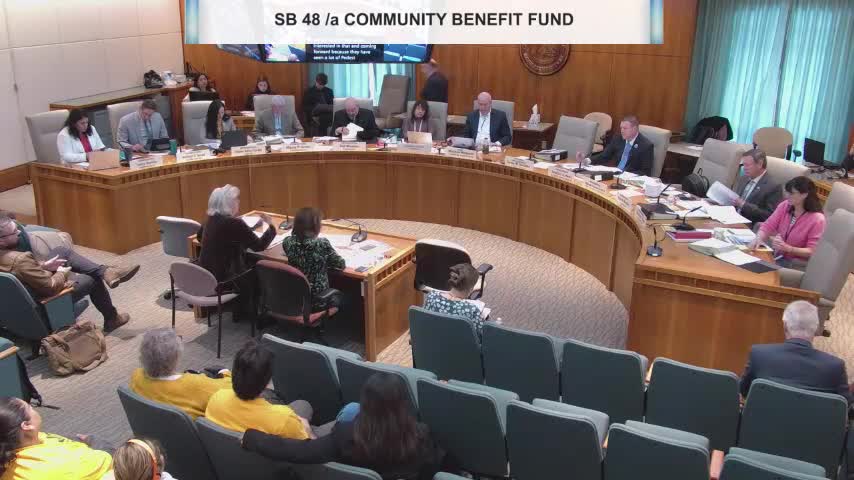New Mexico Committee Discusses Clean Energy Grants and Job Creation Concerns
March 08, 2025 | Energy, Environment & Natural Resources, House of Representatives, Committees, Legislative, New Mexico
This article was created by AI summarizing key points discussed. AI makes mistakes, so for full details and context, please refer to the video of the full meeting. Please report any errors so we can fix them. Report an error »

In a recent meeting of the New Mexico Legislature's House Energy, Environment, and Natural Resources Committee, lawmakers engaged in a robust discussion about the future of renewable energy projects in the state. The meeting, held on March 8, 2025, highlighted the complexities surrounding job creation and the impact of new energy initiatives on local communities.
As the session unfolded, committee members focused on a significant clean energy project in Eddy County, which involves a $230 million investment in battery storage. However, concerns were raised about the project's potential to create jobs, with one member recalling that it was projected to generate only one or two permanent positions. This led to a broader inquiry into the job creation capabilities of the renewable energy sector compared to the traditional oil and gas industry, which currently supports around 30,000 direct jobs in New Mexico.
The discussion revealed a tension between the push for renewable energy and the realities of job sustainability. While the renewable energy sector is growing, with estimates suggesting around 2,000 permanent jobs in solar and 150 in wind energy, lawmakers expressed skepticism about the long-term benefits of transitioning away from fossil fuels. One senator emphasized the need for clarity on how many permanent jobs would remain after renewable projects are completed, questioning the effectiveness of current legislation in ensuring lasting employment opportunities.
Another key point of contention was the broad scope of the proposed legislation, which aims to address various community needs, from infrastructure improvements to renewable energy projects. Some lawmakers cautioned that without a more focused approach, the funding might not achieve its intended goals, potentially diluting the impact of the initiatives.
As the meeting concluded, the committee acknowledged the importance of balancing economic development with environmental sustainability. While there is a clear recognition of the need to transition to cleaner energy sources, the path forward remains fraught with questions about job security and the long-term viability of such projects in New Mexico's diverse economic landscape. The discussions underscored the urgency for data-driven definitions and metrics to guide future decisions, particularly regarding overburdened communities that may be disproportionately affected by these changes.
As New Mexico navigates its energy future, the dialogue continues, reflecting the complexities of balancing economic growth with environmental responsibility.
As the session unfolded, committee members focused on a significant clean energy project in Eddy County, which involves a $230 million investment in battery storage. However, concerns were raised about the project's potential to create jobs, with one member recalling that it was projected to generate only one or two permanent positions. This led to a broader inquiry into the job creation capabilities of the renewable energy sector compared to the traditional oil and gas industry, which currently supports around 30,000 direct jobs in New Mexico.
The discussion revealed a tension between the push for renewable energy and the realities of job sustainability. While the renewable energy sector is growing, with estimates suggesting around 2,000 permanent jobs in solar and 150 in wind energy, lawmakers expressed skepticism about the long-term benefits of transitioning away from fossil fuels. One senator emphasized the need for clarity on how many permanent jobs would remain after renewable projects are completed, questioning the effectiveness of current legislation in ensuring lasting employment opportunities.
Another key point of contention was the broad scope of the proposed legislation, which aims to address various community needs, from infrastructure improvements to renewable energy projects. Some lawmakers cautioned that without a more focused approach, the funding might not achieve its intended goals, potentially diluting the impact of the initiatives.
As the meeting concluded, the committee acknowledged the importance of balancing economic development with environmental sustainability. While there is a clear recognition of the need to transition to cleaner energy sources, the path forward remains fraught with questions about job security and the long-term viability of such projects in New Mexico's diverse economic landscape. The discussions underscored the urgency for data-driven definitions and metrics to guide future decisions, particularly regarding overburdened communities that may be disproportionately affected by these changes.
As New Mexico navigates its energy future, the dialogue continues, reflecting the complexities of balancing economic growth with environmental responsibility.
View full meeting
This article is based on a recent meeting—watch the full video and explore the complete transcript for deeper insights into the discussion.
View full meeting
